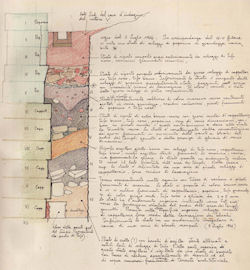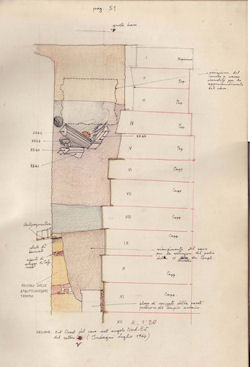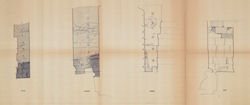
Figure 48: Stratigraphic section of the southern wall of settore V (AFSRCM, S. Omobono, b. 31, 5, cc. 4051.49).
The excavation of settore V was begun between 18 and 24 June 1964, and completed on 11 July of the same year, as indicated in the excavation diary (AFSRCM, S. Omobono, b.31, 5, cc. 4051.47-49, 51, 57-64; a report on the work conducted in 1964 also briefly discusses settore V; AFSRCM, b. 29, c. 3605.1-3). The trench is immediately adjacent to the eastern perimeter wall of the temple platform and is located roughly halfway along it (Figure 34). At least in the initial phases of the work, it seems to have been divided into two areas, the south-eastern and north-eastern corners (this can be seen clearly in a photograph from the excavation diary taken before work started; AFSRCM, b. 31, 5, cc. 4051.57, photograph 66/67). The excavation area, 3.40 x 1.40m on the surface, seems to have become narrower with depth.
On the basis of sketches included in the excavation diary, it seems that below the topmost layer the excavators encountered a pit that cut the pavement slabs of tufo di Monteverde and parts of the ancient stratigraphy (AFSRCM, S. Omobono, b. 31, 5, cc. 4051.47, fig. 1, a schematic east-west section of the southern face of the trench). This pit was probably the same that cut into a drainage duct to the south consisting of tufo blocks with a central channel laid on cappellaccio slabs with a north-to-south slope. To the side were found a clay fill, a layer of tufo fragments, and, below, a layer of peperino fragments. These three layers were interpreted as preparation layers ('assestamento' and 'sottofondazione').
The excavation diary for 3 July includes a colour section of the southern face of the trench with explanatory notes (AFSRCM, S. Omobono, b. 31, 5, cc. 4051.49; Figure 48). The description of the stratigraphic sequence is presented as follows:

Figure 48: Stratigraphic section of the southern wall of settore V (AFSRCM, S. Omobono, b. 31, 5, cc. 4051.49).

Figure 49: Stratigraphic section of the northern wall of settore V (AFSRCM, S. Omobono, b. 31, 5, c. 4051.51).
The sequence is also illustrated by another drawing of the east-west section of the northern face of the trench. The layers in this drawing are not numbered, however, and they do not entirely correspond to the sequence documented in the other section (Figure 49; AFSRCM, S. Omobono, b. 31, 5, c. 4051.51). In the northern area of the trench, at around 0.80m in depth, the excavators encountered 'un muretto in opera cementizia' (a wall in opus caementicium) with east-west orientation, on the southern side of which were found fragments of marble (Figure 50; inventory nos 3342 and 3348). The structure, probably a foundation, was composed of 'schegge di tufo, mattoni di reimpiego, selce, frammenti di marmot e malta di color grigio violetto' (fragments of tufo, reused bricks, basalt, marble fragments, and greyish-purple mortar). After it was removed, additional marble fragments were recovered (Figure 50; inventory nos 3347, 3343, 3340, 3341). Also in the northern face of the trench were medieval pots, which were photographed (the pots can be recognised in layer 'b' in the north face in AFSRCM, S. Omobono, b. 33, 7, c. 4049, but are less easily identifiable in the colour version of the same section included in the excavation diary; the drawing includes all sections from the trench, including the eastern and western faces). Moreover, at a depth of 2.40m from the slabs in tufo di Monteverde, numerous bones, small tufo and cappellaccio blocks, and medieval pottery (a fragment of a jug with handle, fragments of a bowl, and part of a cup) were recovered along with smaller quantities of Archaic impasto pottery, bronze fragments, iron slag, and two Late Imperial coins.
Both section drawings document the eastern wall of the podium, which, according to the excavators, was built of peperino in the top five courses and cappellaccio in the lower seven courses visible at the time. On 10 and 11 July, the continuing excavation revealed the moulding of the first phase of the Archaic temple; concurrently, the excavators began washing the spoil from the foundation deposits. On 14 October 1964, after a partial collapse of the walls caused by heavy rains, a large fragment of a laconic cup with sphinxes was recovered (AFSRCM, S. Omobono, b. 31, 5, c. 4051.75).
Currently, the trench remains backfilled.
Given the limited dimensions of the trench, particularly in the lower portion, and the absence of plans, it is not easy to propose a precise interpretation of the excavation data. The documentation of the old excavation focuses primarily on two stratigraphic sections pertaining to the southern and northern faces of the trench. The first problem concerns the presence of a pit in the upper levels, in the area where the slabs of tufo di Monteverde were absent and the soil appeared loose and contained heterogeneous materials. The position of the limits of this pit is not clear, though it certainly extended to the northern and part of the southern sides of the trench. The section of the northern face (Figure 49) records a series of at least four stratigraphic units, which end in line with the upper portion of the podium block labelled VIII. A first layer of undefined soil was followed by the foundation of the wall, which was probably of late antique or medieval date, given the heterogeneity of the construction materials. Several marble fragments were found within the foundation trench of the wall, while sherds of medieval pottery and Late Imperial coins were recovered from the layers corresponding to the blocks of courses IV-V of the podium (the layers also correspond to courses V and VII, as the lower part of the layers is aligned with the edge of the podium). This group of deposits can therefore be dated, however roughly, to the phases of dismantlement of the sacred area beginning in the late antique period.
The following layer can perhaps be interpreted as a fill to raise the surface level during the construction of the podium. A pit and its fill beneath this layer can be connected to the foundation of the temple platform, extending from courses IX to XI. The pit extends down to the structures of the first Archaic temple, which it cuts. Additionally, the pit cuts six layers, probably connected to the phases of the first Archaic temple, which unfortunately are only partially described in the sketch of the section (three of the layers are simply defined as a 'burnt layer', 'fill of tufo rosso fragments', and 'portions of the structures (?) of the temple'). Given the limited extent of these layers and the inadequate documentation, it is at present impossible to offer any further interpretation.
The section of the southern face is better documented and includes both the number and a brief description of each layer (Figure 48). The structure of the deposit appears different. In the upper part runs a duct connected to the drainage system of the upper part of the podium. This is a particularly important conduit, as it runs along the internal perimeter of the podium and is carefully built. Layer I from the section includes this structure and layers pertaining to its construction (this is the same duct identified in settori VI and VIII). Layer II probably resulted from the accumulation of stone rubble (fragments of cappellaccio and tufo, perhaps construction debris), as did the underlying layer, composed of peperino fragments, which is assimilated to II. The following layers, III-VI, may be interpreted as fills to raise the level of the area in connection with the construction of the perimeter wall of the podium. Layer VII, perhaps a collapse layer, covered the structures of the earliest temple.

Figure 51: Stratigraphic section of the four walls of settore V (AFSRCM, S. Omobono, b 33, 7, c. 4049).
Among the archival documents is a drawing that shows the four sections of the trench (Figure 51; AFSRCM, S. Omobono, 4049). This document presents some differences from the two sections discussed so far, as the layers are differentiated with Arabic numbers and letters, unlike in the excavation diary. Moreover, it includes the southern and western sections and a representation of layer 8, which are completely absent from the excavation diary. While the lower layers of the northern sections could be understood in connection with the last phases of use and the destruction of the Archaic temple, as suggested by the horizontal level of at least two layers, traces of charcoal, and the presence of architectural terracottas, this interpretation is contradcited by the presence of layer 8, which seems to cover all the structures of the temple, unless it is to be understood in connection with the construction of the temple. Given the inconsistencies in the documentation, further investigation is necessary.
The pit in the northern section could also be interpreted as something other than a foundation trench, perhaps a spoliation pit.
By 'correcting' the inclination of the podium of the Archaic temple shown in the western section, which probably resulted from soil movement, it can be observed that the exterior face of the podium was aligned with the preserved limit of the supposed ground surface.
© Internet Archaeology/Author(s)
University of York legal statements | Terms and Conditions
| File last updated: Mon Mar 12 2012